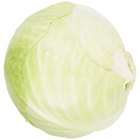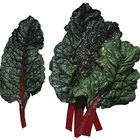
Brief boiling, called blanching, softens crisp cabbage while improving the color and tenderness of the leaves. Cabbage requires blanching before you can freeze it because the process slows flavor and color loss. Blanching also makes the leaves easier to handle when you are making cabbage rolls or other recipes that require whole leaves. The leaves develop a brighter color and wrap more easily around the filling after a short dunk it the boiling water.
Step 1
Remove the outer leaves from the cabbage head and dispose of them. Cut heads into wedges or a coarse shred for freezing, or remove the individual leaves whole for using in cabbage rolls and wraps.
Step 2
Fill a large pot with water and bring it to a boil. Set a bowl of ice water near the cooking area.
Step 3
Add up to 1 pound of cabbage wedges or shredded cabbage to the boiling water. Boil wedges for 3 minutes and shredded cabbage for 1 ½ minutes. Use tongs to hold whole cabbage leaves and submerge them individually in the water for only 30 seconds, or just until they begin to wilt.
Step 4
Remove the cabbage from the water, using a slotted spoon if necessary, and immediately submerge the cabbage in the ice water. Add more ice, if necessary, and allow the cabbage to cool completely.
Step 5
Drain the cabbage and pat the leaves dry with a towel. Use immediately or transfer to a freezer-safe storage container and store in a 0-degree Fahrenheit freezer for up to 12 months.
Related Articles

How to Cut Cabbage Very Finely

How to Steam Cabbage on the Stove

How to Blanch Kale for Freezing

How to Steam Cook Cabbage

How to Cook Mixed Greens

How to Make Collard Greens With Smoked ...

How to Cook Corned Silverside in a Slow ...

How to Blanch Tomatillos

How to Make N.Y. Deli-Style Coleslaw
How to Cook Cabbage in a Microwave Oven

How to Juice a Daikon Radish

How to Boil Celery

Steamed or Boiled Cauliflower

How to Cook Fresh Broccoli in a Slow ...

How to Cook Fresh Baby Spinach for ...

How to Crush Mint

How to Make Galumpkies (Polish Cabbage ...

How to Freeze Turnips & Mustard Greens

How to Cook Swiss Chard Italian Style

How Fast Does Cooked Spaghetti Squash ...
References
Tips
- Blanching tenderizes and improves freezer quality for all cabbage varieties, including red and green cabbages, as well as the looser heads of Chinese and Napa varieties.
Writer Bio
Jenny Harrington has been a freelance writer since 2006. Her published articles have appeared in various print and online publications. Previously, she owned her own business, selling handmade items online, wholesale and at crafts fairs. Harrington's specialties include small business information, crafting, decorating and gardening.
Photo Credits
Stockbyte/Stockbyte/Getty Images